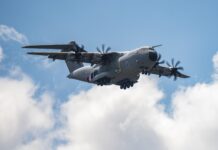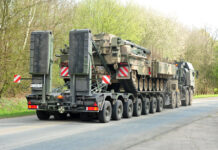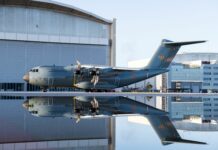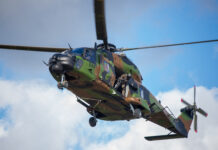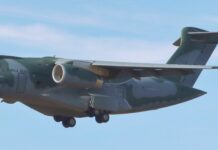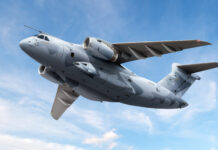Within the last two decades the airlift capabilities of Europe’s air forces have been – and continue to be – significantly renewed and enhanced, but with high-intensity conflict having returned to Europe since 2022, questions remain as to whether this rejuvenation goes far enough.
Less than two decades ago Europe’s air forces effectively had no indigenous strategic airlift capacity and were significantly dependent of the services on the US Air Force’s Air Mobility Command to rapidly transport significant numbers of troops or sizeable armoured vehicles.
In recent years, however, that picture has changed, with European air forces developing transport fleets that at least approach offering a strategic airlift capability, yet this is a situation that has been more than 40 years in the making.
The A400M programme
It was, in fact, in 1982 when the effort to provide a replacement for the Lockheed C-130 Hercules and Transall C-160 transport aircraft then in European service first began. It was not until 1995, however, that Airbus was tasked with taking industrial responsibility for developing what was then known as the European Future Large Aircraft (FLA).
![An Airbus A400M in French service, pictured on 25 June 2024. As things stand there will ultimately be 170 A400Ms in service with European air forces. [Armée de l'Air et de l'Espace]](https://euro-sd.com/wp-content/uploads/2025/06/French-A400M-Armee-de-lAir-et-de-lEspace-Kopie-1024x683.jpg)
Nowadays the advent of the A400M is seen as a very successful programme, but the development of the aircraft was not without its painful beginnings. In May 2003 Airbus Military selected a new European-designed powerplant for the aircraft, rather than an off-the-shelf engine from Pratt & Whitney Canada, in the form of the TP400-D6 engine produced by Europrop International: a consortium comprising MTU Aero Engines, Safran Aircraft Engines, Rolls-Royce and ITP Aero. However, a number of gearbox and certification problems with the engine developed that pushed the A400M programme to the right, while weight issued threatened to undermine the aircraft’s payload requirements.
While the first A400M made its maiden flight on 11 December 2009 out of the Airbus facilities in Seville, Spain, pressure mounted from European air forces as a result of programme delays, with some orders being reduced and South Africa cancelling an order it had placed for eight aircraft in 2009.
Nevertheless, serial production of the A400M began in January 2011 and in August 2013 the first production aircraft was handed over to the French Air Force. Then, on 9 May 2015, tragedy struck when an A400M crashed in Seville on its first test flight, killing four of the six crew on board. This led to the aircraft already delivered to some air forces being grounded as the crash was investigated. The crash was subsequently attributed to a software issue with the full authority digital engine control (FADEC) system. However, on 19 June 2015, A400M deliveries restarted and the programme has not looked back since.
According to Airbus Military data updated as of 30 April 2025, 178 A400Ms have been ordered, of which 131 have been delivered and are operational. In Europe the A400M fleet figures are as follows:
- Seven ordered by Belgium, all of which are operational;
- 50 ordered by France, of which 24 have been delivered and are operational;
- 53 ordered by Germany, of which 48 have been delivered and are operational;
- One ordered by Luxembourg, which is operational;
- 27 ordered by Spain, of which 14 have been delivered and are operational;
- 10 ordered by Türkiye, all of which have been delivered and are operational;
- 22 ordered by the UK, all of which have been delivered and are operational.
This totals 170 A400Ms ordered by European states, of which 126 have been delivered and are operational.
![The first flight of a Spanish Air Force A400M on 5 September 2016. As things stand there will ultimately be 170 A400Ms in service with European air forces. [Airbus]](https://euro-sd.com/wp-content/uploads/2025/06/Spanish-A400M-Airbus-Kopie-1024x683.jpg)
The A400M has the ability to carry a 37 tonne payload over 3,704 km (2,000 NM) to established and remote civilian and military airfields, as well as short unprepared or semi-prepared strips. The aircraft’s payload capacity means that it can carry a medium-weight armoured vehicle, a Chinook helicopter or 116 fully equipped troops, with paratroopers able to exit via static lines via the two side doors or in freefall via the rear ramp.
A key attribute of the A400M, along with its capability to land on austere runways, is the aircraft’s ability to carry two under-wing aerial refuelling pods, allowing operators to use their A400Ms to refuel a variety of other aircraft. The Luftwaffe is one of the largest operators of these pods.
The C-17
Supplementing Europe’s A400M fleets are a limited number of European-owned Boeing C-17 Globemaster III airlifters, although the UK’s Royal Air Force (RAF), which operates eight of the type, is the only independent operator of the C-17 in Europe, while another three are operated by NATO.
The RAF’s inaugural fleet of four Boeing C-17s were initially acquired on a seven-year lease, with the first aircraft arriving at RAF Brize Norton in May 2001, but the UK ultimately converted its C-17 acquisition to a fleet of eight permanently owned aircraft, the last of which was delivered in May 2012.
With the RAF subsequently receiving its first A400M in November 2014 and last one in May 2023 – the Atlas fleet, as it called by the RAF, has completely replaced the RAF’s Hercules C4/C5s (C-130J-30/Js) – the UK, unsurprisingly for an island nation, thus owns one of Europe’s most significant national airlift capabilities.
NATO’s Strategic Airlift Capability (SAC), meanwhile, was established on 23 September 2008 as a multinational initiative that provides its participating nations with assured access to military airlift capability. Under the initiative the multinational NATO Airlift Management Programme (NAMP) has ownership of a fleet of three C-17s on behalf of SAC member nations, with the aircraft registered and flagged in Hungary. The SAC programme’s operational arm, the Heavy Airlift Wing, is based at Pápa Air Base in Hungary.
![NATO’s Strategic Airlift Capability, which operates three C-17s, was established on 23 September 2008 as a multinational initiative that provides its participating nations with assured access to military airlift capability. [NATO]](https://euro-sd.com/wp-content/uploads/2025/06/NATO-C-17-NATO-Kopie-1024x768.jpg)
The SAC received its first C-17 on 14 July 2009, with the second and third aircraft delivered in the following months. The HAW achieved full operating capability in November 2012.
The C-17s of the RAF and the Heavy Airlift Wing are Europe’s most capable airlift assets. Powered by four Pratt & Whitney F117-PW-100 turbofans each offering a thrust of 179.90 kN, each Globemaster III can transport a 45,360 kg load more than 8,334 km (4,500 NM) while flying at altitudes above 10,668 m (35,000 ft) and has a maximum payload capacity of 76,655 kg.
The design of the C-17, which is 53.04 m long and has a 51.74 m wingspan, is such that it enables high-angle, steep landing approaches at relatively slow speeds, allowing it to operate into small, austere airfields and onto runways as short as 1,067 m (3,500 ft) long and just 27.4 m (90 ft) wide.
The C-390
Beyond the A400M and C-17 and third aircraft type has been making significant inroads into the European airlift market in the form of the C-390 Millennium from Brazil’s Embraer. The advent of the C-390 in Europe has arguably been driven by two main factors: firstly, the need for European air forces to recapitalise their transport fleets as older C-130 Hercules fleets required replacing; and secondly, the return to Europe of high-intensity conflict in the form of Russia’s February 2022 invasion of Ukraine, which forced European nations to look again at their capacity to rapidly airlift troops and materiel in response to a military crisis.
The first C-390 prototype made its maiden flight on 3 February 2015 and the type entered operational service with the Brazilian Air Force on 4 September 2019. Unsurprisingly, given its language commonality with Brazil, the first European nation to buy the C-390 – and the type’s first export customer – was Portugal, which ordered five aircraft in 2019 to replace the Portuguese Air Force’s (FAP’s) C-130H fleet. These aircraft, which were the first fully NATO-configured Millennium aircraft, were ordered as KC-390 variants, meaning they can act as aerial refuelling platforms for fighter aircraft as well being able to refuel each other. The FAP received its first KC-390 in October 2023, the second in June 2024 and is scheduled to receive the remaining three aircraft by March 2027.
Then, in 2020, the Hungarian Air Force ordered two KC-390s, the first of which was delivered in September 2024. Since the Hungarian order no less than six other European air forces have also ordered the Millennium.
In June 2022 the Netherlands became the third European national to select the type, opting for C-390s to replace the Royal Netherlands Air Force’s C-130H fleet, while in September 2023 the Austrian Air Force announced its selection of the C-390 to replace its C-130Ks. A joint contract ceremony for both nations was held at the Farnborough International Airshow on 22 July 2024, during which the Dutch Ministry of Defence signed a contract for the acquisition of nine C-390s: five for the Royal Netherlands Air Force and four for the Austrian Air Force, with deliveries beginning in 2027.
In October 2023 it was announced that the Czech Air Force had selected the Millennium, after which a contract for two C-390s was signed in October 2024. At that time the Czech Ministry of Defence stated that the first C-390 might be delivered as early as 2025, with the second one arriving in 2027 or 2028.
![A CG render of an Embraer KC-390 in Swedish service. Sweden is one of seven European countries to have selected the Millennium. [Embraer]](https://euro-sd.com/wp-content/uploads/2025/06/Swedish-KC-390-Embraer-Kopie-1024x576.jpg)
Slovakia announced its intention to purchase the C-390 in December 2024, with the Slovak Ministry of Defence announcing at the time that it would start begin formal negotiations on the purchase of three aircraft in January 2025.
Then, at the Paris Air Show in June 2025, as well as Portugal adding a sixth A400M to its order, along with taking up 10 options for sales to potential allies, Airbus announced that Lithuania had selected the Millennium.
Powered by a pair of IAE V2500-E5 turbofans each delivering a thrust of 139.4 kN, and with a length of 35.2 m and a wingspan of 35.05 m, the C-390 is billed by Embraer as being able to fly faster, further and carry more payload than any other aircraft in its class. The aircraft can carry a maximum (concentrated) payload of 26 tonnes, has a maximum cruise speed of 870 km/h and has a range of 2,000 with a 26-tonne load or 2,722.44 with a 23-tonne load (although the KC-390 can, of course, be refuelled mid-flight). The Millenium, like the A400M, is also able to operate from austere, semi-prepared runways.
Is it enough?
Thus, it can be seen that, certainly in comparison with two decades ago, the collective airlift capabilities of Europe’s air forces are in a much better position than they were. However, in the context of the Europe’s current military-geopolitical climate, in which high-intensity conflict has returned to the continent following Rusia’s invasion of Ukraine, the question arises of whether Europe’s collective military airlift capabilities are enough. In this regard, one fact that cannot be ignored is that, of the aircraft types discussed in this article, only the C-17 can be regarded as a truly strategic airlift asset in that it can transport a main battle tank (MBT), whereas the A400M and C-390 cannot. While the A400M can certainly carry a tracked armoured vehicle such as Germany’s Puma infantry fighting vehicle, this can only be achieved with the Puma in its light ‘A’ (air-transportable) armour kit fitted. The Boxer 8×8 multi-role armoured vehicle in service with Germany, Lithuania, the Netherlands and the UK can fit on an A400M, but only by separating its drive and payload modules.
While the RAF has its fleet of eight C-17s, NATO’s Heavy Airlift Wing, with just three C-17s, starts to look more like a token gesture when it comes to the airlifting of heavy armour. In light of the conflict in Ukraine, the purchase of additional C-17 might have seemed like a like a good idea for the Heavy Airlift Wing, but this is no longer an option: the plant at Long Beach, California, that made the Globemaster III was closed down by Boeing after the last C-17 was delivered in 2015 and, although Boeing had made 10 more C-17s than it had orders for when it closed the line, these have all been sold.
That said, with the replacement of Transall C-160s (which had a maximum payload of 16 tonnes) and C-130s (the H model of which has a maximum payload of 19 tonnes) by A400Ms and C-390s, Europe’s collective airlift capability has certainly been enhanced.
Ongoing heavy lift requirements
With regard to Europe’s ongoing ability to rapidly move heavy armour across the continent amid heightened tensions with Russia, considerable onus falls in three key areas: continued reliance on US Air Mobility Command; the effective prepositioning of armour within NATO’s multinational battlegroups in Bulgaria, Estonia, Hungary, Latvia, Lithuania, Poland, Romania and Slovakia; and European efforts to facilitate the rapid transportation of heavy equipment across the continent by road, rail and sea, as addressed by the EU’s Action Plan on Military Mobility 2.0, Permanent Structured Cooperation (PESCO) Military Mobility project and Network of Logistic Hubs in Europe and Support to Operations (NetLogHubs) project.
Asked how well set NATO’s European nations are in fulfilling their ongoing strategic airlift requirements, a NATO spokesperson told ESD on 23 May 2025, “Robust strategic airlift capabilities are an important part of building resilience and contribute to effective deterrence and defence. The Alliance supports the pooling of resources between nations in order to expand reach, improve response rates and benefit from economies of scale. NATO remains ready to respond to any threat.”
When ESD approached the RAF to enquire about the current state of the air force’s strategic airlift capabilities, an RAF spokesperson replied on 21 May 2025, “The RAF is well set to meet our strategic lift needs now and in the future. We use a combination of the C-17 and the A400M. These aircraft provide the capability to transport personnel, equipment and supplies to various operational theatres globally. In addition to these aircraft, the Voyager [the A330-based Multi-Role Tanker Transport aircraft, of which the RAF operates nine] plays a crucial role in refuelling and transporting personnel.”
![A Boeing C-17 in RAF service. The RAF is Europe’s sole independent operator of the C-17, with a fleet of eight aircraft. [Crown Copyright]](https://euro-sd.com/wp-content/uploads/2025/06/RAF-C-17-Crown-Copyright-Kopie-1024x682.jpg)
Looking ahead, if Europe’s air forces beyond the RAF were to consider standing up their own truly strategic airlift capabilities beyond NATO’s three Hungary-based C-17s, it is not impossible to consider a future venture with Ukraine’s Antonov: manufacturer of the 150-tonne-payload An-124 Ruslan airlifter. Beyond the aircraft in Russian military service, a small number of An-124s are still operated commercially and have in the past been contracted for airlift duties by NATO countries. However, while the war in Ukraine continues such a plan remains a mere future theoretical possibility, while modernising an aircraft that first flew in 1982 would be a considerable undertaking.
Peter Felstead



![French A400M (Armée de l'Air et de l'Espace) Kopie An Airbus A400M in French service, pictured on 25 June 2024. As things stand there will ultimately be 170 A400Ms in service with European air forces. [Armée de l'Air et de l'Espace]](https://euro-sd.com/wp-content/uploads/2025/06/French-A400M-Armee-de-lAir-et-de-lEspace-Kopie.jpg)


![Transport aircraft trends: A market overview The Xi’an Aircraft Industrial Corporation (XAC) Y-20 entered service with the Chinese military in 2016; the aircraft can be considered the Chinese equivalent of the Boeing C-17. A tanker variant is available, while the Y-20 also provides the basis for the new KJ-3000 AEW&C platform. [Cute Orca Weibo Account]](https://euro-sd.com/wp-content/uploads/2025/06/Y-20-China-Kopie-218x150.jpg)
